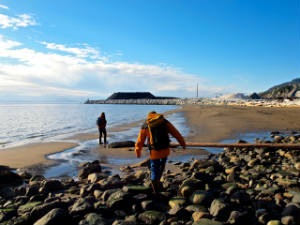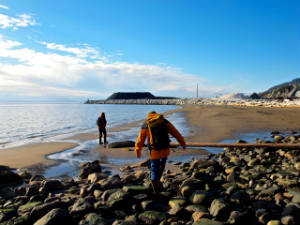
On the morning of October 27, I was excited not to have to go into the office, but not for the reasons one might think. As an articled student for WCEL, I look forward to going to the office because everyone there is so inspirational and the work they do seems so worthwhile, I am thankful just to be a part of it all. This day was not any different except I had a change of venue.
This morning, I was attending a legal challenge brought by Voters Taking Action on Climate Change (VTACC) – with support from West Coast’s Environmental Dispute Resolution Fund (EDRF) – in the BC Supreme Court at Vancouver courthouse. VTACC’s Lawyer, Tim Howard, was asking the court to overturn a Ministry of Mines (MEM) decision to amend a permit to allow for expansion of coal handing at a Lafarge Canada facility on Texada Island (TQL). Howard was arguing that the Ministry of Environment, not the MEM, should have been the government agency making decisions about coal handling.
 I received some information about the case in advance in order to be prepared for what to expect in terms of content, and I thought I had a fair idea of what the courtroom would be like, having been to master’s chambers, federal court and, well, traffic court. But once I arrived to this courtroom I was shocked at how small it was. I anticipated a number of rows of chairs for viewers to observe, as there had been in the other courts, however, in this instance, there was only one row with about 12 seats pinched in along the back wall; and most of them were taken by the time I got there. (I actually arrived late because there is a new pay system for the underground parking lots at the courthouse and I spent half an hour looking for the meter to pay. For future reference, the meters are by the Seymour entrance.)
I received some information about the case in advance in order to be prepared for what to expect in terms of content, and I thought I had a fair idea of what the courtroom would be like, having been to master’s chambers, federal court and, well, traffic court. But once I arrived to this courtroom I was shocked at how small it was. I anticipated a number of rows of chairs for viewers to observe, as there had been in the other courts, however, in this instance, there was only one row with about 12 seats pinched in along the back wall; and most of them were taken by the time I got there. (I actually arrived late because there is a new pay system for the underground parking lots at the courthouse and I spent half an hour looking for the meter to pay. For future reference, the meters are by the Seymour entrance.)
The line of seats was naturally separated into “sides” by the doorway. All of the seats were filled on VTACC’s side but the overflow seemed to begrudgingly sit behind opposing counsel. When I entered, those on the overflow had to shuffle over a seat in order to accommodate me because there wasn't enough room for me to move around them. By the time I finally sat down I could see Mr. Howard was well into submitting his arguments on behalf of VTACC. He stood alone, surrounded by mass amounts of binders splayed out along the table beside him and behind him.
Background
Texada Quarries Limited (TQL) currently handles up to 400,000 tonnes of coal each year but the permit amendment would mean that it could handle up to 8 million tonnes of US thermal coal each year. This expansion would serve the planned coal port at Fraser Surrey Docks (FSD) whereby the coal would be delivered by railway to FSD, then loaded onto open barges for towing to TQL’S deep-water facility. From there it would be stockpiled at the TQL site, then loaded onto ocean going vessels to be delivered to Asian customers for combustion. The problem with this circumstance is that TQL is not a coalmine, but it has been storing and shipping coal at this mine location for the past decade or so. This expansion is too large to go unnoticed any longer.
VTACC is a volunteer group who obviously cares about climate change and they pride themselves on creating opportunities for people to place demands on municipal, provincial and federal governments to take meaningful action in order to reduce green house gas emissions. Their members have been following this expansion closely as they believe this is a public concern that will have long-term effects on our air, lands and waters and they are willing to take it to court to evoke change.
The Hearing
It was impressive to watch Mr. Howard maneuver through his submissions with use of those large binders as he articulated VTACC’s primary argument: that the Chief Inspector of the MEM does not have jurisdiction under the Mines Act to authorize TQL’s coal storage and shipping operations because Lafarge’s operation is a coal shipping and handling facility, not a mine. Plus, Mr. Howard pointed out that the Ministry of Environment (MOE) incorrectly declined to exercise its powers under the more suitable (and more stringent) Environmental Management Act (EMA) to require Lafarge to get a waste management permit for their operations.
In the alternative, even if MEM were the appropriate jurisdiction for this project, Mr. Howard argued that by withholding pertinent information from the public to enable public input on the proposal, the actions of the Chief Inspector were unreasonable based on the administrative law rules of natural justice and procedural fairness.
Even though it took Mr. Howard all day (he spoke from 10:00am to 4:00pm, virtually uninterrupted, with only an hour lunch and two 15-minute breaks) he articulated VTACC’s arguments clearly while maintaining a quiet confidence that even had the judge nodding along as Mr. Howard led her through the binders of evidence – possibly in agreement? We have to wait and see.
The next day, I could only stay until noon, but that was long enough for me to hear the gist of the arguments coming from the team of respondents: two lawyers for Lafarge and one from the BC Attorney General's office. They contended VTACC should not even be able to bring this case to court because the issue is not a matter for public interest, that members of VTACC are not directly impacted, which means they do not have a recognizable dispute; especially since those more directly affected (i.e. the employees and adjacent town, filled with employees) have refused to bring this case forward.
The respondents argued there are sufficient standards within the Mining Act that provide for appropriate environmental standards that are being met in this circumstance, despite there being no environmental assessments of the surrounding area completed under the EMA. They even go so far to say that without this permit, the miners’ safety would be at risk because they would be wandering around in a hazardous work environment, vulnerable, without even the minimum of regulations to protect them. And so, they argued, this case should be dismissed because it is frivolous and VTACC is just using this situation as a “bully pulpit” to pick on TQL and the provincial government.
Conclusion
The outcome of this case will provide an interesting addition to administrative law and questions of jurisdiction and deference. Does the BCSC have to defer to the discretionary power of the MEM and MOE who have, apparently for TQL’s convenience, decided this activity falls under the Mining Act? The fact that this facility is not a mine is undisputed. This cannot be ignored. The assertions made by the respondents who insist that stretching the Mines Act beyond its intended scope of application is necessary to save TQL’s workers from regulatory chaos is absurd. Moreover, addressing issues over whether or not this activity is a public concern seems elementary. After all, if people cannot challenge government actions in court, the government will be, or be seen to be, above the law; and the rule of law will essentially become meaningless.
Quashing this Permit Amendment will mean that the intended expansion will not continue without proper authorization. Regulating this facility under the jurisdiction of the MOE will basically ensure higher environmental and safety standards are being upheld, rather the minimum as set out in the Mining Act. I hope the BC Supreme Court agrees.
By Robyn Raymond, Articling Student
Related post - Challenging U.S. coal to China from Texada, BC.